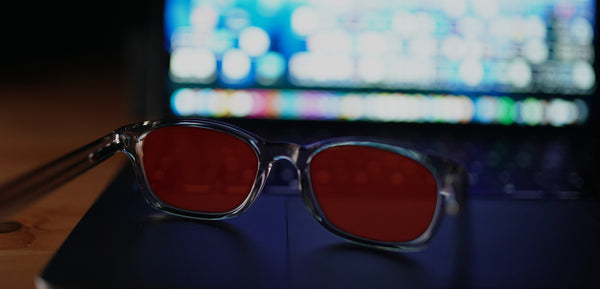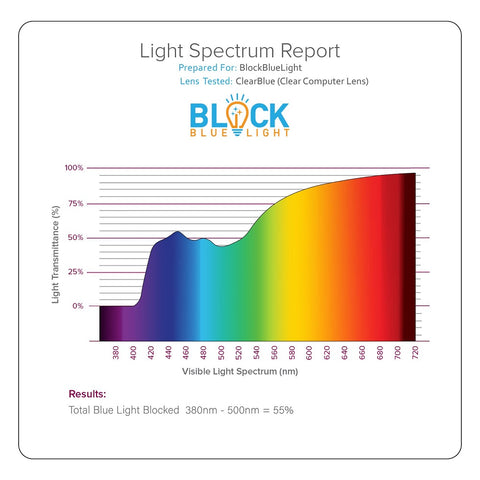You must have heard of blue light blocking glasses- doctors and scientists are recommending them because of their benefits for your eyes, sleep, and health. The hype around blue light glasses may have you wondering, ‘how do blue light glasses work?’
It’s important that you understand how blue light glasses work so you can decide whether or not they will work for you and how you can best use them.
How do blue light glasses work?
Blue light glasses work by having special lens technology developed to either filter or block out blue light completely.
Blue light is one of the colours in the visible light spectrum that can be seen by human eyes. Sunlight contains the full spectrum of light - red, orange, yellow, green, blue, indigo and violet. The colours towards the end of the spectrum, specifically blue light (380-500nm) are short wavelengths, which means they produce higher amounts of energy.

Is blue light harmful?
The truth is, during the day blue light is present all around us. The sun is the biggest source of blue light. We need blue light to regulate our circadian rhythm and for the release of hormones. However artificial blue light from LED lighting and screens is not the same as natural blue light from the sun. Artificial blue light is void of the full colour spectrum and very high in the blue light spectrum, which makes it unnatural and harmful.
Exposure to natural levels of blue light during the day has the following benefits:
- Blue light exposure during the daytime boosts alertness, helps memory and cognitive function and elevates mood.
- It regulates a normal circadian rhythm – the circadian rhythm is the body’s natural wake and sleep cycle.
- If children do not receive enough sunlight, the growth and development of their eyes can be harmed.
Unfortunately, nowadays our exposure to blue light has passed the healthy limit- thanks to bright LED lights, fluorescent lights, screens, and digital devices.
The answer to the question ‘how do blue light glasses work,’ is that they reduce our exposure to excess levels of blue light and filter it down to the required natural levels (different amounts for day and night), this is achieved with special pigments embedded into lenses that target the exact harmful wavelengths of light that needs to be filtered or blocked.
Exposure to excess levels of blue light during the day (from artificial sources) has the following harmful side effects:
- Digital eye strain: Blue light from computer screens and digital devices decreases contrast which leads to digital eye strain. Sore or irritated eyes and difficulty focusing are symptoms of eye strain.
- Retina damage: Continued exposure to blue light over time can lead to damaged retinal cells. This causes age-related macular degeneration and other vision problems.
Exposure to blue light after dark has the following drawbacks:
Blue light exposure at night is a huge problem. This is because, after sundown, we are not supposed to be exposed to any amount of blue light.
Exposure to blue light late at night (through smartphones, tablets, and computers) disturbs the wake and sleep cycle, leading to problems sleeping and daytime tiredness.
Exposure to blue light stimulates the circadian clock (your internal sleep-and-wake clock) more than traditional light sources, thus disrupting your sleep and having other effects on your circadian rhythm.
How do blue light blocking glasses work?
We get a lot of questions from people who are evaluating whether they need blue light blocking glasses, such as, ‘How do blue light glasses work?’ and ‘how does the blue light filter work?’
Continue reading if you want to learn the answer to the following questions, and also learn about whether you can use daytime blue light glasses at night or whether there are night-time blue light blocking glasses that can be worn during the day, or if there’s a single set of glasses suitable for both day and night.
Blue light glasses for daytime:
Daytime blue light computer glasses work by filtering down the correct wavelengths of blue light that screen and modern lighting emits. Daytime computer glasses do not block blue light completely because it is needed by the body- they only filter blue light down to normal levels.
The peak wavelength of blue light that devices and LED lights emit is 440-455nm. This wavelength produces the highest amount of energy and is the most damaging wavelength responsible for retina damage, eye strains and other health problems.
For daytime glasses to be effective, they must filter down the peak wavelength of blue light at 440-455nm by 50%.
Our ScreenTime Computer Glasses filter blue light by 50% across the entire blue light spectrum (380nm-500nm). This means that the eyes are protected from the peak wavelength where most of the damage occurs.
Be careful when choosing a pair of daytime computer glasses as many cheap clear lenses don’t filter any part of the peak wavelength of 455nm. If the company doesn’t provide the specifications of the exact wavelengths they are filtering, it’s a red flag they’re not going to be effective!
Blue Light Blocking Glasses for night-time:
After sundown, naturally, we are not supposed to be exposed to any amount of blue light. To get better sleep we need to ensure we have no exposure to blue or green light up to 550nm. This is why we need blue blocking glasses that block 100% of blue light and green light up to 550nm to mimic the conditions of nature.
If you have the question: how do blue light glasses work to make this happen, the answer is through the special pigments embedded in the lens to target the harmful wavelengths (they are not simply a tinted lens). Night-time blue blocking glasses are amber or red-tinted and they block 100% of blue light (and some amount of green light) to ensure that melatonin is produced in natural quantities.
Melatonin is the hormone responsible for regulating our circadian rhythm (or sleep cycle). It is released when light is dim and it promotes restful sleep. Exposure to blue light suppresses the production of melatonin. Thus the use of screens and LEDs after sunset makes it difficult to fall asleep. Even if you fall asleep, sleep quality is diminished, resulting in you feeling tired after a full night’s rest.
As surprising as it may sound, blue light is not the only culprit. The melatonin disruption zone spreads into the green spectrum too. Melatonin is released by photosensitive retinal cells that contain melanopsin. These cells are disrupted by wavelengths up to 550nm which means green light also needs to be blocked at night to encourage sleep.
In our range of glasses for use after sunset, we have the nocturnal red lenses which blocks 100% of blue light and 100% of green light up to 550nm. These premium blue and green light lenses ensure that all the wavelengths of the melatonin disruption zone are blocked, to ensure have naturally high melatonin levels to aid deep and restful sleep. If your night-time blue blocking glasses don’t block all blue and green light up to 550nm they won’t be doing a very good job!

Research on the topic: how do blue light glasses work to encourage melatonin production has shown the following results: A study by the University of Toronto revealed that people who wore glasses that block blue light wavelengths, produced greater amounts of melatonin than those who didn't during night shifts. Additional studies have revealed that blue light suppresses delta brainwaves, which encourage sleep and boost alpha wavelengths, which are responsible for creating alertness.
Can I wear the same blue light glasses for day and night both?
As convenient as it is to own a multi-use gadget, wearing the same pair of blue light blocking glasses during the day and night both is not possible.
Daytime glasses filter only 50% of blue light rays, so wearing them after sundown won’t fix the issue of melanin disruption as even a small percentage of blue light at night will tell your brain its daytime and suppress melatonin.
Wearing night-time glasses (which block 100% of blue and green light up to 550nm) during the day, will confuse the body into thinking it’s night-time and cause a circadian rhythm mismatch, and leave you feeling tired and unmotivated. Over time, a lack of blue light during the day will start to cause depression and seasonal affective disorder symptoms so only filtering blue light by 40-50% is necessary for long term health.
In short, wearing the wrong glasses at the wrong time will cause more harm than good, so it’s very important to have the right set of glasses for the right time of the day (and night) as each set does a very different job.
Choosing blue light blocking glasses that truly work:
When buying any health product, it’s imperative that you test to see whether the product is a gimmick or will actually benefit. Many blue light glasses are being sold at low prices but their lenses don’t have the characteristics to benefit your health
When buying blue light glasses for daytime, here are the things you need to check for;
- Which range of spectrum do the lenses provide protection from? You need to ensure you have protection across the entire spectrum of blue light that filter 40-50%. (any less than 40% filtering is not enough, and more than 50% is too much)
- Do the computer glasses provide protection at the peak wavelength of blue light (450-455nm)? This is the range where most of the damage occurs. If the exact specifications of the wavelengths filtered are not mentioned, its more than likely they are inadequate.
When buying blue blocking glassses for night-time, here are the things you need to check for;
- Do the glasses block 100% of blue light across the entire spectrum of blue light?
- Do the glasses filter out green light up to 550nm as well (remember that green light is also responsible for melatonin disruption, so if you’re looking for blue light glasses that work at night, you will need green light protection).
Amy L Sheppard, J. S. (n.d.). Digital eye strain: prevalence, measurement and amelioration. Retrieved from BMJ Journals: https://bmjophth.bmj.com/content/3/1/e000146
Bradford, A. (2016, 2 27). How Blue LEDs Affect Sleep. Retrieved from Live Science: https://www.livescience.com/53874-blue-light-sleep.html#:~:text=become%20a%20problem.-,Research%20has%20found%20that%20exposure%20to%20blue%20light%20suppresses%20the,to%20this%20type%20of%20light.
Holzman, D. C. (2010, 1). What’s in a Color? The Unique Human Health Effects of Blue Light. Retrieved from NCBI: https://www.ncbi.nlm.nih.gov/pmc/articles/PMC2831986/
Prevent Blindness.org. (n.d.). Blue Light and Your Eyes. Retrieved from Prevent Blindness: https://preventblindness.org/blue-light-and-your-eyes/
Ramsey, D. (2019, 5 1). Will blue light from electronic devices increase my risk of macular degeneration and blindness? Retrieved from Harvard Health: https://www.health.harvard.edu/blog/will-blue-light-from-electronic-devices-increase-my-risk-of-macular-degeneration-and-blindness-2019040816365
Shadab A. Rahman, e. a. (2013, 7). Effects of Filtering Visual Short Wavelengths During Nocturnal Shiftwork on Sleep and Performance. Retrieved from NCBI: https://www.ncbi.nlm.nih.gov/pmc/articles/PMC3786545/









